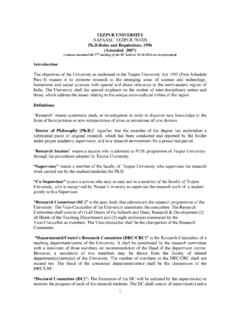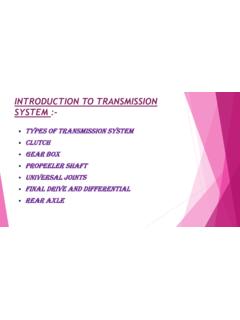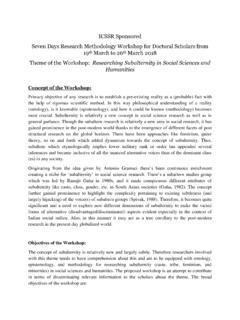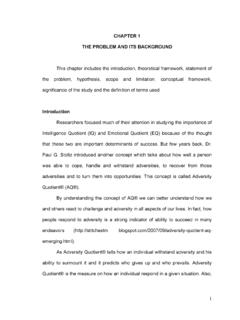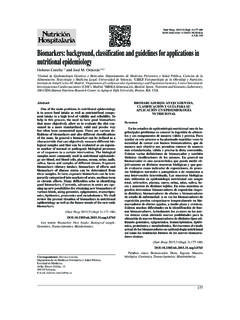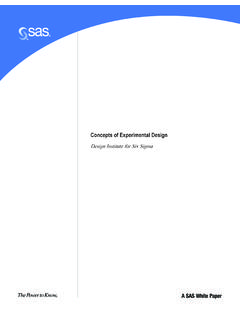Transcription of CHAPTER 1 AN OVERVIEW OF MANAGEMENT …
1 1 CHAPTER 1 an overview of management information system definition OF MIS: A MANAGEMENT information system is An integrated user-machine system For providing information To support the operations, MANAGEMENT , analysis, and decision-making functions In an organization The system utilizes Computer hardware & software Manual procedures Models for analysis, planning, control, and decision making, and A database Fig: PYRAMID STRUCTURE OF MIS MIS AND OTHER ACADEMIC DISCIPLINES: MANAGERIAL ACCOUNTING OPERATION RESEARCH MANAGEMENT AND ORGANIZATION THEORY COMPUTER SCIENCE MIS for Strategic and policy Planning and Decision making MANAGEMENT information for tactical planning and decision making MANAGEMENT information for Operational planning, decision making, and control Transaction processing Inquiry response 2 SUBSYSTEMS OF AN MIS: Two approaches of defining the subsystems of an MIS are : According to the organizational functions which they support According to managerial activities for which they are used.
2 ORGANIZATIONAL FUNCTION SUBSYSTEMS: ACTIVITIES SUBSYSTEMS: Major Functional subsystem Some typical uses Marketing Sales forecasting, sales planning, customer and sales analysis Manufacturing Production planning and scheduling, cost control analysis Logistics Planning and control of purchasing, inventories, distribution Personnel Planning personnel requirements, analyzing performance, salary administration Finance and accounting Financial analysis, cost analysis, capital requirements planning, income measurement information processing information system planning, cost-effectiveness analysis Top MANAGEMENT Strategic planning.
3 Resource allocation Activity subsystem Some typical uses Transaction processing Processing of orders, shipments, and receipts Operational control Scheduling of activities and performance reports MANAGEMENT control Formulation of budgets and resource allocation Strategic planning Formulation of objectives and strategic 3 Fig: RELATION OF ACTIVITIES TO FUNCTIONAL SUBSYSTEMS MIS AS SEEN BY THE USER: Database MANAGEMENT system Database MarketingProductionLogistics Personnel Finance &AccountingInformation ProcessingTop MANAGEMENT ACTIVITIES Strategic MANAGEMENT Control Operational Transaction USER USES Clerical personnel Handle transactions, process input data and answer inquiries First-level managers Obtain operations data.
4 Assistance with planning, scheduling, identifying out-of-control situations, and making decisions Staff specialists information for analysis. Assistance with analysis, planning and reporting MANAGEMENT Regular reports. Adhoc retrieval requests. Adhoc analyses. Adhoc reports. Assistance in identifying problems and opportunities. Assistance in decision-making analysis. 4 CHAPTER 2 STRUCTURE OF A MANAGEMENT information system information system can be classified in terms of the following. 1. Operating elements 2. Decision support 3. MANAGEMENT activity 4. Organizational function 1. OPERATING ELEMENTS OF AN information system : A. PHYSICAL COMPONENTS: Hardware : Hardware must provide for five major functions: 1.
5 Input or entry 2. Output 3. Secondary storage for data and programs 4. Central processor 5. Communications Software : The software can be classified into two major types: system software & Application software Database The database contains all data utilized by application software. Procedures Three major types of procedures are required: 1. User instructions 2. Instructions for preparation of input by data preparation personnel 3. Operating instructions for computer operations personnel Operations personnel Computer operators, systems analysts, programmers, data preparation personnel, information systems MANAGEMENT , data administration, etc. 5B. PROCESSING FUNCTIONS: 1.
6 Process Transactions : 2. Maintain Master Files : 3. Produce Reports : TRANSACTIONS FILES PROCESS TRANSACTIONS TRANSACTION DOCUMENTS Performance of a transaction requires records to (1) Direct a transaction to take place, (2) Report, confirm, or explain its performance Or (3) Communicate the transaction to those needing a record for background information or reference MASTER FILE CHANGES MASTER FILE UPDATE MASTER FILES Many processing activities require creation and files maintenance of master files, which store relatively permanent or historical data about organizational entities. When transactions are processed, master file data items are updated to reflect the most current information UPDATED MASTER FILES TRANSACTION DATA REPORT FILES PREPARE REPORT Scheduled reports are produced on a regular basis.
7 Special reports are also produced quickly based on ad hoc (unscheduled) requests. 64. Process Inquiries : 5. Process Interactive Support Applications : C. OUTPUTS FOR USERS : 1. Transaction documents or screens 2. Preplanned reports 3. Preplanned inquiry responses 4. Ad hoc reports and inquiries responses 5. User-machine dialog results Transactional documents are of the following types : 1. Informational Reports or confirms that action that will be or has been taken. 2. Action Requests or instructions for action. 3. Investigational Reports exceptions, errors, or other conditions that may require investigation. Used for control and future reference. INQUIRY RESPONSE HANDLE INQUIRY Other outputs are responses to inquiries using database.
8 Inquiries may be regular inquiries with a preset format or ad hoc inquiries. INQUIRY INQUIRY INQUIRY RESPONSE DECISION MODEL PROCESSING The information system contains applications designed to support systems for planning, analysis and decision making. MODEL INPUT AND DECISION MAKER OR ANALYST 7 Reports, inquiry responses, and dialog results provide four types of information : 1. Monitoring information Monitoring information provides a basis for problem finding and diagnosis and may lead to action, but no action is specified by the information itself. 2. Problem finding information The information is presented in a format that promotes identification of problems. 3. Action information The information is presented with action specified or implied.
9 4. Decision support The report, inquiry, result, or dialog is oriented to performing analysis and making a decision. Preplanned reports have a regular content and format and are usually run on a regularly scheduled basis. Prepared at a given time, they reflect one of three conditions with respect to the time period they cover: 1. They describe status or condition at a point in time. 2. They summarize what has occurred during a period such as a week, month, or year. 3. They present results to date and project to the end of the period. Ad hoc reports and inquiry responses occur at irregular intervals and require data or analysis whose format has not been preplanned. Ad hoc request are handled in two ways : 1.
10 The user may be provided with a means (inquiry language) for preparing and processing the request. 2. An information service may be available to process ad hoc requests. 2. MANAGEMENT information system SUPPORT FOR DECISION MAKING Decisions are of different types with respect to the structure that can be provided for making them. Structured, Programmable Decisions A structured decision can be said to be programmable, in the sense that unambiguous decision rules can be specified in advance. When a decision can be programmed, an organization can prepare a decision rule or decision procedure. This can be expressed as a set of steps to follow, a flowchart, a decision table or formula.


